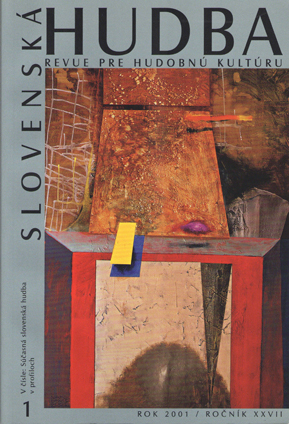1/2001: Súčasná slovenská hudba v profiloch

1/2001: Súčasná slovenská hudba v profiloch
Úvodom
URBANCOVÁ, Hana: Úvodom
In: Slovenská hudba, roč. 27, 2001, č. 1, s. 3 – 4
Štúdie
CHALUPKA, Ľubomír: Cestou hľadania maxím... Reflexie k tvorbe Mira Bázlika
In: Slovenská hudba, roč. 27, 2001, č. 1, s. 5 – 29
Miro Bázlik (b. 1931) holds a special position among the composers emerging in Slovak music at the end of the 1950s and in the course of the 1960s. The uniqueness of his stylistic formation lies in the fact that he was not enticed by the avant-garde tendencies; his relationship with the present grew slowly and with inner logic. He was educated in two fields – mathematics and composition. However, he mixed the rational with the emotional in a complementary way. In the first period of his maturation (1958–1975), respect and thorough knowledge of the past were the basic features of his development, especially his affinity to Bach, from whom he sought to gain ideas for contemporary composition. He presented his interpretation of twelve-tone music (rejecting the strict rules) fairly early, in his Songs on Chinese Poetry and in his graduation composition Music for Violin and Orchestra. He further developed his musical expression in large-scale works, e.g. opera Peter and Lucy, oratorio The Twelve, and Canticum for soprano, choir and orchestra. In the latter two, he elevated the sonic concept of the clash of distinct multilayered motives on to a higher level of sonic blocks and zones. From there he naturally proceeded towards electroacoustic composition. His personal evolution culminated in the cycle Spectra – a very personal confrontation of selected preludes and fugues from Bach’s Well-Tempered Clavier with electronically manipulated sound material. In juxtaposing seemingly contrasting inspirational sources, Bázlik explored the possibilities and the limits of joining traditional and contemporary elements into homogeneous units, stressing their deeper links rather than superficial differences.
ĎURČEKOVÁ, Zuzana: Štruktúry – filmová hudba Ilju Zeljenku
In: Slovenská hudba, roč. 27, 2001, č. 1, s. 30 – 50
Ilja Zeljenka (b. 1932) rose to prominence in the 1960s not only as a composer of classical contemporary music, but also as a composer of film scores. His extensive involvement with motion picture was sparked off by professional encounters with the director Štefan Uher, whose aesthetics made an impression on the young composer. Zeljenka wrote music for films until 1973, when he was deemed “unwanted” by the regime. After that he returned to film scores only occasionally. Between 1957–1973, he wrote music to about a hundred films, the majority of them being documentaries and full length films. He collaborated with several prominent Slovak directors (Štefan Uher, Eduard Grečner, Oto Krivánek, Ladislav Kudelka, Martin Slivka, Miloslav Kubík, Miroslav Horňák, Jozef Zachar, Vlado Kubenko, etc.).
Zeljenka was most creative in writing music for art documentaries. In spite of its close association with the film itself, this music can exist on its own, as an autonomous work of art.
The composition Structures for orchestra (1964) was originally written to a documentary The Soul of a Stone (1964) by Jozef Zachar. The poetic film tells the story of the suffering and the struggle of Slovaks in World War II as seen through war monuments. The paper is an essay in analysis of film music and its ties to the images; it also compares the film version with the concert version of the piece. The paper concludes with a reflection on music’s ability to interact with visual image and to function independently as an autonomous art form at the same time.
Film music opens up possibilities of collaboration among different forms of art, and the film scores of Ilja Zeljenka prove the mutual benefits of such collaboration.
MARTINÁKOVÁ, Zuzana: Litánie okamihu. K hudobnej tvorbe Juraja Hatríka
In: Slovenská hudba, roč. 27, 2001, č. 1, s. 51 – 63
The paper focuses on the life and works of Juraj Hatrík (b. 1941), one of the representatives of contemporary Slovak music, member of the older generation of composers. The first part brings the basic biographical data pertaining to his activities as composer and teacher. The main part attempts to outline the style and aesthetics of his music by bringing examples of selected compositions in chronological order with the aim to define the specifics of Hatrík’s poetics. The paper includes a chronological list of works and a selected bibliography.
PLANČÁROVÁ, Martina: Inšpiračné východiská tvorby Martina Burlasa
In: Slovenská hudba, roč. 27, 2001, č. 1, s. 64 – 80
The Slovak music of the 1980s saw the emergence of a generation of the first post-modern wave. Martin Burlas (b. 1955) is the oldest and the most radical representative of this generation. His earliest works reveal an aesthetics, in which creation is perceived as a kind of escape from the outside reality. Composition means for Martin Burlas creation of his own private parallel world. His early works are characterised by emotion, abrupt changes of expression, and heterogeneous horizontal structure, which leads to a mosaic-like design. More recent works involve heterogeneous vertical structures, as a result of simultaneous diverse sound layers producing an effect of compact sound. His musical expression is confined to melancholy, hopelessness, introversion; irony plays an important part in his artistic profile.
His music is varied in style and genre: chamber music, stage works, electroacoustic music, and alternative rock. With the use of the chosen examples of his chamber and electroacoustic music, we followed the relationship between the minimalist technique and the musical form on the background of semantics and expressive power. Burlas’ music is a testimony to the current inner world of modern man – it is a mirror reflecting today’s world and today’s man.


